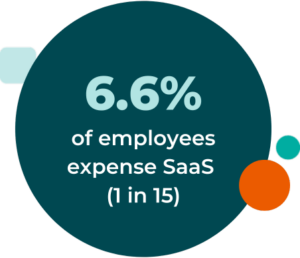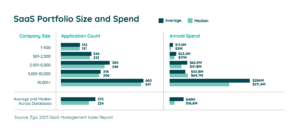Table of Contents
Spending too much time and effort routing IT support requests for SaaS applications? Imagine a scenario where your support team no longer needs to play the role of traffic cop.
IT support plays a pivotal role in every enterprise. From deploying and maintaining hardware to onboarding new employees with the right tools to troubleshooting software applications, few modern businesses can operate effectively without continuous assistance from IT support.
However, an outcome of the growing use of cloud-based subscription software applications (also known as SaaS) is added complexity to providing internal support. This challenge stems from the increasingly decentralized and more democratic, employee-led nature of software acquisition. Due to the ease with which SaaS applications can be acquired, business units and individual employees now frequently and quickly select, purchase, and deploy software without the need for an IT support professional.

This trend will continue to grow. Zylo data shows that employees and businenss units are responsible for 84% of application spendings, not IT. A recent Zylo data analysis based on more than $30 billion in cloud spend under management showed that 1 in 15 (6.6%) employees use expense reimbursement to acquire SaaS applications.
 But while IT may no longer be involved in every decision for SaaS applications (since individual teams and users now frequently do so themselves), it’s can still be expected to provide technical assistance for SaaS applications – no matter how it was acquired.
But while IT may no longer be involved in every decision for SaaS applications (since individual teams and users now frequently do so themselves), it’s can still be expected to provide technical assistance for SaaS applications – no matter how it was acquired.
Whether SaaS application acquisition has been decentralized unknowingly (as is the case with shadow IT) or knowingly (as in the case of organizations with IT governance structures that promote team- or employee-based application management), companies that fail to adapt to the growing change in software ownership risk forgoing the organizational flexibility needed to foster innovation.
Increased SaaS Adoption Leads to Increased IT Support Needs
Gartner predicts worldwide end-user spending on SaaS to grow 19% in 2025 to total $299B. SaaS is by far the most substantial portion spend category within the cloud market at around 35%.

For most organizations, this increased spending leads to greater quantities of applications. According to Zylo data, the average organization has 275 applications a 2.2% increase from 2023. But that’s for companies actively managing their SaaS. Those same organizations average 7 apps entering their environments each month. If left unmanaged, that would drive 33% portfolio growth (a.k.a. SaaS sprawl) over the course of a year.

And when overall application quantity grows, so does the complexity in providing IT support. Consider the following. According to Zendesk, approximately 70% of internal support tickets reach a “resolved” status in one touch.
However, the average resolution time takes slightly more than 24 hours. This data may suggest that IT support may be too busy to provide resolutions more quickly. On average, Zendesk says internal support teams handle about 500 tickets per month.
According to IT support advisory firm HDI, after factoring in all costs (including technology, training, and personnel salaries), the total cost of ownership for an IT support ticket averages $104. Businesses with IT practices that effectively prevent issues from reaching IT support can quickly reduce associated operational costs.
IT Support in Distributed Management SaaS Environments
As mentioned above, one of the primary drivers of increased SaaS application acquisition and use in business environments is the reduced need for IT support in the acquisition or deployment of a new tool.
To adapt to this new reality, progressive IT teams have developed new tiered approaches and governance for the management and support of SaaS applications.
IT managed and supported
- Essential applications for mission-critical business operation
- Contain sensitive data requiring high levels of security and data compliance
- May be deployed widely across an organization with a high volume of users with complex support needs
- Examples: CRMs, Office suites
Unmanaged but supported (distributed management)
- Application(s) critical for business effectiveness, but not necessarily mission-critical
- Day-to-day managed by a subject matter expert or other administrators, but not IT
- Scope of deployment and functionality includes specific business units, departments, or teams
- Examples: Document storage, HCM, Finance tools, Marketing tools, team collaboration, and project management platforms
Unmanaged and unsupported (typically shadow IT)
- Applications can improve employee effectiveness and productivity but not required to run business
- May be acquired and deployed by smaller teams and end-users
- Examples: Productivity tools, calendar apps
Since the “managed and supported” category follows a traditional model of IT support and the “unmanaged and unsupported” class of applications are excluded from IT support, the “unmanaged but supported” group of applications creates new challenges for IT support teams.
If IT does not directly manage or own the day-to-day activities for an application, but remains responsible for its support, that support frequently becomes playing the role of “traffic cop” by routing requests to the application owner.
Take a common request such as onboarding a new employee with the Day One tools and applications. If you’re the IT support agent in charge of this process, you’d likely get a list of applications required for the new employee.
When these applications are unmanaged but supported, this requires the IT support agent to:
- Determine which department, team or employee owns each application
- Send a provisioning request to the respective owner
- Report back on the status of the ticket’s resolution
While each of these steps seems reasonably straightforward, it requires more than 24 hours to accomplish and costs more than $100 per instance on average.
Enabling Self-Service Support for SaaS Applications
According to Metricnet benchmarks, when an end-user can identify their issue and solve it on their own accord, it costs just $2 per instance. In many cases, self-service SaaS is accomplished via improved training for employees or creating content in knowledge centers. And employees, like all consumers, increasingly expect to self-direct their technology experiences. For example, by 2023, Gartner predicts 40% of workers will choose business applications and tools like they do their music streaming experience.
But in the case of SaaS applications, the diversity of titles (the average company has 323 titles in its inventory) and the increasing likelihood that an application may not be directly managed by IT (as more companies embrace governance structures that distribute management) frequently prevents self-service resolutions. IT support continues to play traffic cop, routing support requests to the application owner, who then resolves or closes the request.
In a perfect world, an employee who wants to request access to a new SaaS application would have access to a list of available applications maintained by their employer. This list could be pre-configured by job roles so that only qualified employees had access to specific types of applications (for example, a call-center employee wouldn’t qualify for access to HR-specific applications).
The list or catalog of available applications would also feature ownership information. Featuring this ownership information would make it easy for users to submit a request directly to the application’s owner or day-to-day manager. This scenario would reduce the number of traffic cop-style IT support instances, costs, and time to resolution.
Progressive organizations that can discover all SaaS applications within their environment can introduce new and more flexible frameworks for governance and support. When this discovery and distributed management foundation includes the ability to view and self-direct service requests to application owners, these organizations can significantly reduce the time, cost, and effort of providing IT support for SaaS applications.

